|
Following
Gandhi's Path - Part 7
The
Salt March - Gandhi's and My Own
By Jan
Oberg
TFF director
Here's how it
began...
On the 2nd of March 1930, Gandhi sent a letter to Lord
Irwin, the English viceroy, to warn him that an action of
civilian insubordination was to start the 12th of July.
In the letter, he assures the viceroy that no harm would
be done to any Englishman. However, he also states that
the whole British colonial empire is a form of
exploitation and has destroyed Indian culture and
enslaved the population. It is obvious that the British
have no intention of making any changes that might have
an impact on commercial interests. The purpose of the tax
system is to cut out the country's farmers.
"Even the salt that the peasants need for their
subsistence has had taxes imposed on it, so that they
shall pay the most", Gandhi wrote. "However, you
personally have a salary amounting to 7000 dollars a
month. That is 235 dollars a day compared with the
average Indian income of 4 cents a day! You can hardy use
so much money, so I am convinced you give some of it to
charity. However, such a system deserves to be thrown on
the refuse heap. Only organised non-violence can stop the
organised violence of the British government".
Gandhi continues by explaining that those
participating in this action of civilian disobedience
would "ignore" the salt tax and would readily accept
imprisonment, in case the letter does not appeal to
Irwin's heart. Should Irwin be prepared to discuss the
matter, they would certainly call off the action. This
letter, Gandhi reassures, is not a threat, but an
invitation for open communication, the main duty of a
satyagrahi (truth warrier).
Irwin himself did not reply. He did not arrest Gandhi
either - yet.
The Salt March
began on the 12th of March 1930, 6:30 a.m.
Not quite 80 of Gandhi's followers left Sabarmati on
the 12th of March at 06:30. The idea was to wander
southward along the west coast, gather support in the
villages, make speeches and mobilize the press both at
home and in England. That morning, nobody, not even
Gandhi, had any idea of how or where it would end -
namely on a godforsaken beach in a tiny village, Dandi,
the 5th of April, 385 kilometres to the south.
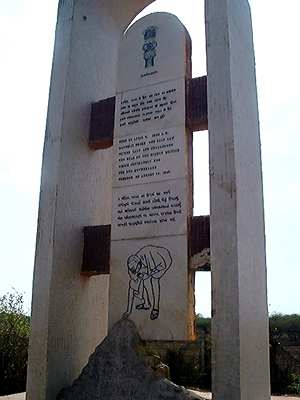
Photo Jan Öberg, © TFF
2001
Monument at Dandi, where Gandhi
picked up a handful of salt
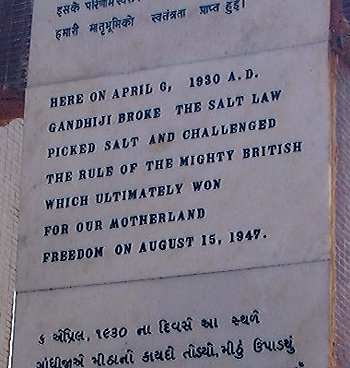
Photo Jan Öberg, ©
TFF 2001
Text on the Salt March
monument
The salt was the symbolic means, while the
independence of India was the purpose -which was not
achieved until 17 years later!
Nearly 20 years ago, Tom
Weber, Australian Gandhi expert and TFF-adviser,
repeated the whole march on his own. His enormously thick
book, in which he investigates the Salt March by means of
"participatory observation", was published in 1997,
On
the Salt March. The Historiography of Gandhi's March to
Dandi, (Harper Collins, Delhi, 594 pages, 2nd Ed
2000) - or here
(hard cover).
In a mixture of fiction and literary road movie, Weber
undertook a meticulous investigation of all the sources
and talked to everyone who participated in the original
March. He has created a priceless chronology and analysis
of this political action for independence, which is
probably the most peculiar of its kind in world history.
It's absurd theatre, existentialism, symbol politics and
realpolitik, all in one. It's farce and tragedy. It's
"the Drama by the Seaside", through which the Englishmen
finally realised that it was the beginning of the
end.
Those who have seen the film about Gandhi probably
remember the brutal scene at the saltworks in Darasana.
2500 satyagrahis had come up from Bombay. Row
after row of white-clad, unarmed marchers were clubbed
and fell bleeding. On the very first day two of them were
killed and 320 wounded. Many of them were arrested, the
prisons were filled quickly and Gandhi himself was taken
to the prison at Puna.
All this happened just a few days after he had picked
up a muddy, sandy clump on the seaside near Dandi, thus
defying the British rule. As Louis Fischer writes in his
classical biography, The Life of Mahatma Gandhi
(Harper & Row 1950), "India was now free.
Technically, however, nothing had changed legally. Tagore
explained the difference - those living in England now
realised that Europe had lost all of its moral
prestige".
My Own March
On the 12th of March 2001 at 06:30 a.m., I started
marching through the gate of the Sabarmati ashram, at the
same high speed during the first 6-7 kilometres down to
Ellis Bridge. An almost full moon was visible in the
west, while the sun rose above the river. People looked
out from under their blankets to see the strange man
(that was me) with his camera, papers and pen. Good
Morning! I tried to imagine what the participants of the
March would have been thinking just then. After all, they
had left their wives and children behind in the ashram,
fully aware of the fact that they might be killed for the
Indian cause.
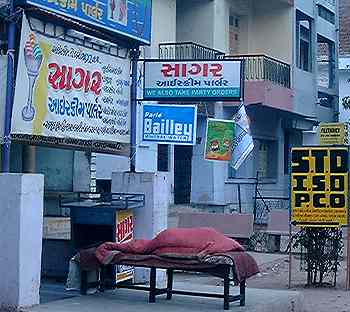
Photo Jan Öberg, © TFF
2001
Morning on Ashram Road
1
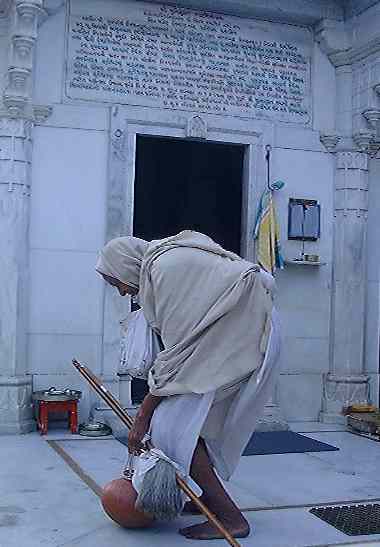
Photo Jan Öberg, ©
TFF 2001
Morning on Ashram Road 2
Today, Ashram Road is a three-laned road with shops
and cinemas, etc. 71 years ago, it was just a gravel road
between the city-centre and the village which surrounded
the ashram. The air is fairly clean; the infernal traffic
noise has not started yet. A camel starts to pee just as
I'm passing by.
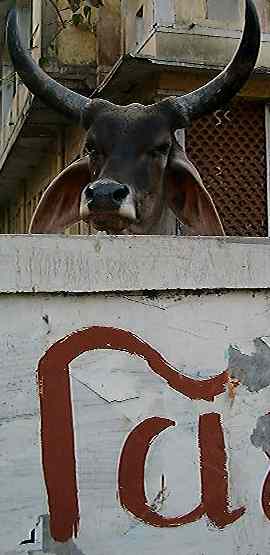
Photo Jan Öberg, © TFF
2001
Morning on Ashram Road
3
I reach Gandhi Bridge at 07:15 and see an enormous
statue of Gandhi, bathed on one side in the red light of
the sun. He stands there in the middle of traffic,
surrounded by advertisements, including those for
cigarettes and alcohol. Poor Mahatma!

Photo Jan Öberg, © TFF
2001
Gandhi on Ashram
Road
I walk further, past Nehru Bridge and, at 07.50, go
over Ellis Bridge in towards the centre. I look down at
the nearly dried up river valley where several men sit on
their heels shitting.
I stroll to Ahmedabad's luxurious Holiday Inn and eat
breakfast with delicious pineapple lassi (yogurt).
Here I can also transfer my handwritten notes to my
palm-computer. It is fascinating to be able to leave one
kind of world and enter into another in practically no
time at all. The question is if we all really live in the
same world?
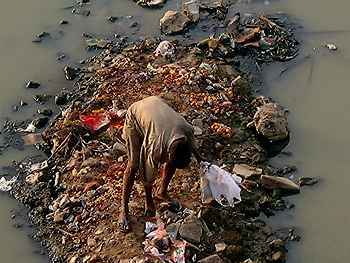
Photo Jan Öberg, © TFF
2001
Morning in the Sabarmati
river
That was the first part of my private Salt March. In
the next article I shall have reached the sea. By car.
With someone who was there then, in 1930.
July 2001
Translated by Alice
Moncada
Translation edited by Sara E. Ellis
Other
articles about India, "Following Gandhi's Path" and
picture galleries
©
TFF 2002

Tell a friend about this article
Send to:
From:
Message and your name
|